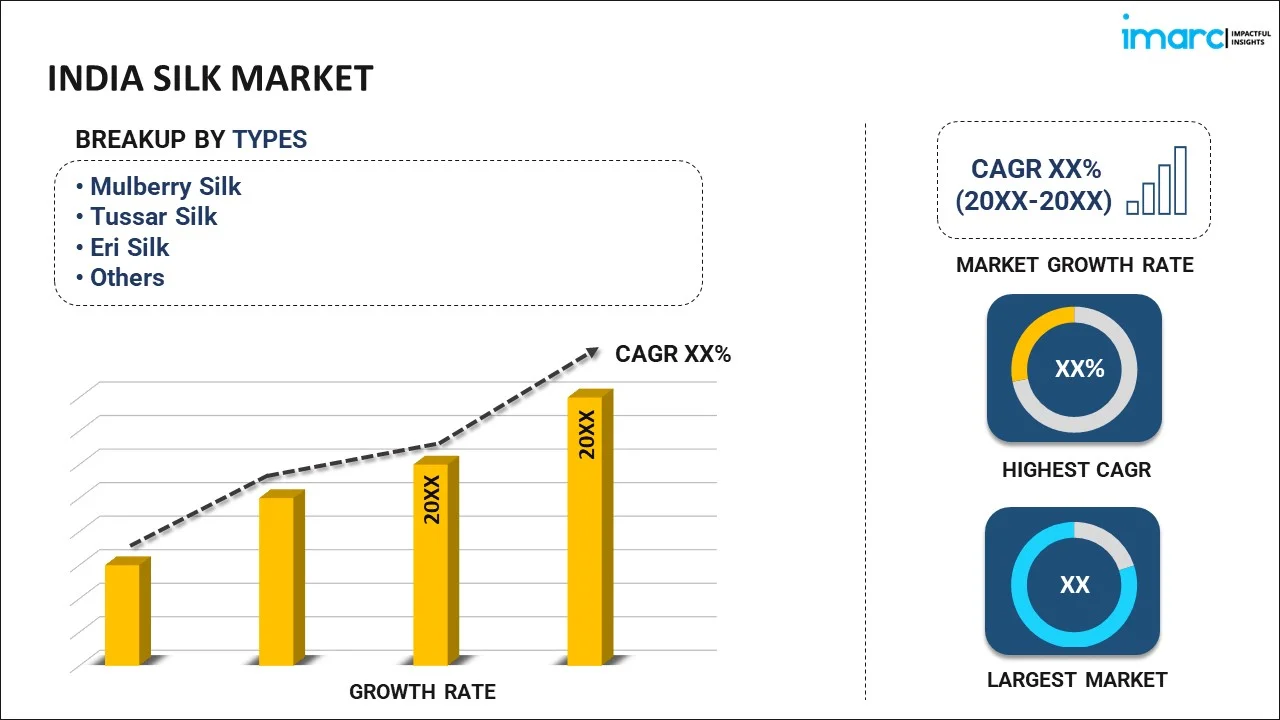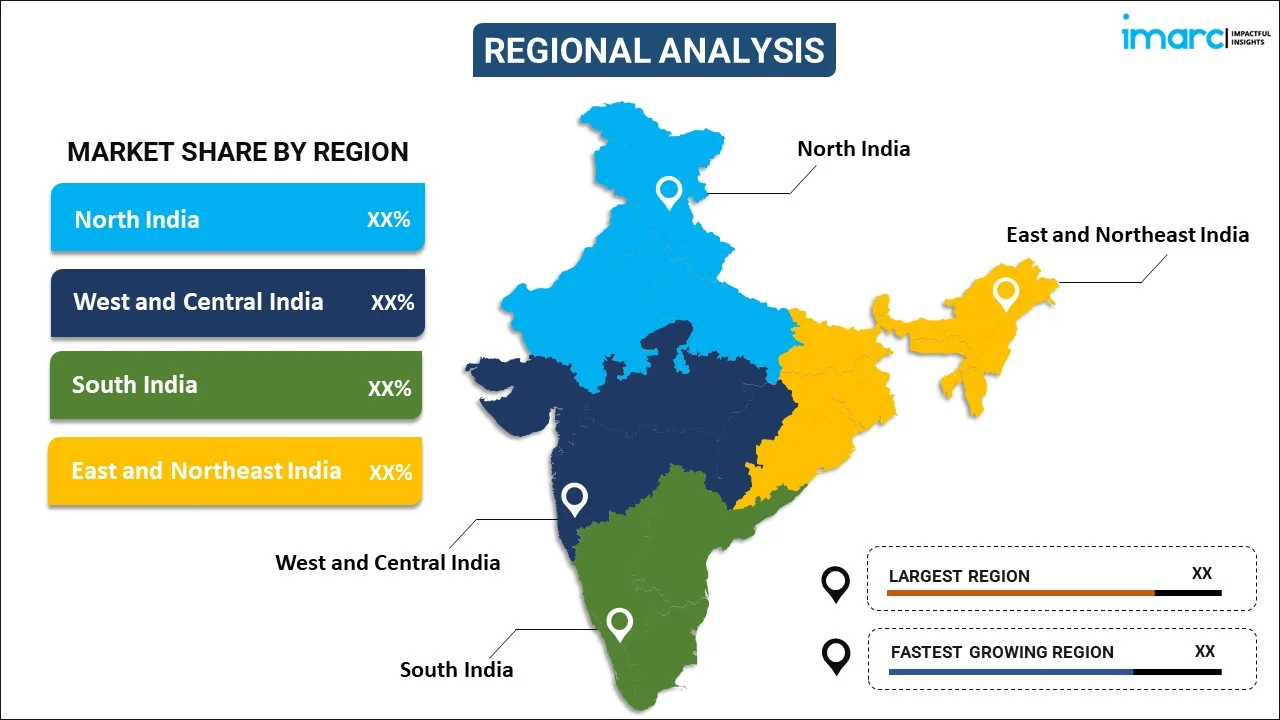
India Silk Market Report by Type (Mulberry Silk, Tussar Silk, Eri Silk, and Others), Application (Textile, Cosmetics, Medical), and Region 2025-2033
Market Overview:
India silk market size reached 39.6 Thousand Tons in 2024. Looking forward, IMARC Group expects the market to reach 54.9 Thousand Tons by 2033, exhibiting a growth rate (CAGR) of 3.4% during 2025-2033. The changes in fashion preferences, including a growing interest in sustainable and eco-friendly fabrics, that can impact the demand for silk, is driving the market.
|
Report Attribute
|
Key Statistics
|
|---|---|
|
Base Year
|
2024
|
|
Forecast Years
|
2025-2033
|
|
Historical Years
|
2019-2024
|
|
Market Size in 2024
|
39.6 Thousand Tons |
|
Market Forecast in 2033
|
54.9 Thousand Tons |
| Market Growth Rate 2025-2033 | 3.4% |
Silk, an exquisite and luxurious fabric, has captivated humanity for centuries with its unmatched beauty and smooth texture. Derived from the silkworm's cocoon, silk is a natural protein fiber that boasts a remarkable combination of softness, sheen, and strength. Renowned for its natural luster and lightweight feel, silk is a staple in the world of fashion, adorning elegant garments and accessories. Beyond its aesthetic appeal, silk possesses unique temperature-regulating properties, making it comfortable in both warm and cool climates. The versatility of silk extends beyond fashion to various applications, including fine furnishings, artwork preservation, and even medical sutures. Silk's timeless allure endures as a symbol of refinement, weaving a rich tapestry of tradition, craftsmanship, and sophistication.
India Silk Market Trends:
The silk market in India is driven by various factors, each interconnected and influencing the industry's dynamics. Firstly, the growing demand for luxury textiles has propelled the silk market to new heights. Consumers, increasingly conscious of quality and elegance, are opting for silk products, bolstering the market's expansion. Moreover, the rise of the fashion industry acts as a significant catalyst, as designers in India incorporate silk into their creations, driving both innovation and demand. Additionally, the regional awareness of sustainable and eco-friendly products has spurred the silk market, given silk's natural origins and biodegradability. Furthermore, advancements in technology have revolutionized silk production, enhancing efficiency and reducing costs. The integration of automation and modern farming practices has streamlined the silk manufacturing process, making it more accessible and economically viable. In tandem, government initiatives supporting sericulture and silk production have provided essential impetus, promoting the industry's development. In essence, the silk market in India thrives on a combination of consumer preferences, technological innovations, environmental considerations, and supportive policies, illustrating its multifaceted and interconnected nature.
India Silk Market Segmentation:
IMARC Group provides an analysis of the key trends in each segment of the market, along with forecasts at the country level for 2025-2033. Our report has categorized the market based on type and application.
Type Insights:

- Mulberry Silk
- Tussar Silk
- Eri Silk
- Others
The report has provided a detailed breakup and analysis of the market based on the type. This includes mulberry silk, tussar silk, eri silk, and others.
Application Insights:
- Textile
- Cosmetics
- Medical
A detailed breakup and analysis of the market based on the application have also been provided in the report. This includes textile, cosmetics, and medical.
Regional Insights:

- North India
- West and Central India
- South India
- East and Northeast India
The report has also provided a comprehensive analysis of all the major regional markets, which include North India, West and Central India, South India, and East and Northeast India.
Competitive Landscape:
The market research report has also provided a comprehensive analysis of the competitive landscape. Competitive analysis such as market structure, key player positioning, top winning strategies, competitive dashboard, and company evaluation quadrant has been covered in the report. Also, detailed profiles of all major companies have been provided.
India Silk Market Report Coverage:
| Report Features | Details |
|---|---|
| Base Year of the Analysis | 2024 |
| Historical Period | 2019-2024 |
| Forecast Period | 2025-2033 |
| Units | Thousand Tons |
| Scope of the Report | Exploration of Historical Trends and Market Outlook, Industry Catalysts and Challenges, Segment-Wise Historical and Future Market Assessment:
|
| Types Covered | Mulberry Silk, Tussar Silk, Eri Silk, Others |
| Applications Covered | Textile, Cosmetics, Medical |
| Regions Covered | North India, West and Central India, South India, East and Northeast India |
| Customization Scope | 10% Free Customization |
| Post-Sale Analyst Support | 10-12 Weeks |
| Delivery Format | PDF and Excel through Email (We can also provide the editable version of the report in PPT/Word format on special request) |
Key Questions Answered in This Report:
- How has the India silk market performed so far and how will it perform in the coming years?
- What has been the impact of COVID-19 on the India silk market?
- What is the breakup of the India silk market on the basis of type?
- What is the breakup of the India silk market on the basis of application?
- What are the various stages in the value chain of the India silk market?
- What are the key driving factors and challenges in the India silk?
- What is the structure of the India silk market and who are the key players?
- What is the degree of competition in the India silk market?
Key Benefits for Stakeholders:
- IMARC’s industry report offers a comprehensive quantitative analysis of various market segments, historical and current market trends, market forecasts, and dynamics of the India silk market from 2019-2033.
- The research report provides the latest information on the market drivers, challenges, and opportunities in the India silk market.
- Porter's five forces analysis assist stakeholders in assessing the impact of new entrants, competitive rivalry, supplier power, buyer power, and the threat of substitution. It helps stakeholders to analyze the level of competition within the India silk industry and its attractiveness.
- Competitive landscape allows stakeholders to understand their competitive environment and provides an insight into the current positions of key players in the market.
Need more help?
- Speak to our experienced analysts for insights on the current market scenarios.
- Include additional segments and countries to customize the report as per your requirement.
- Gain an unparalleled competitive advantage in your domain by understanding how to utilize the report and positively impacting your operations and revenue.
- For further assistance, please connect with our analysts.
 Inquire Before Buying
Inquire Before Buying
 Speak to an Analyst
Speak to an Analyst
 Request Brochure
Request Brochure
 Request Customization
Request Customization




.webp)




.webp)












